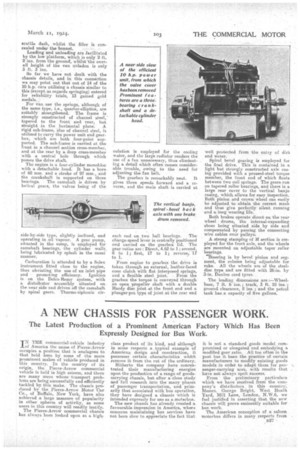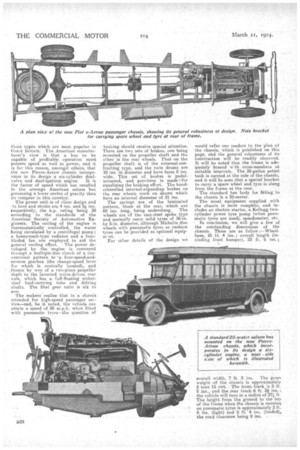A NEW CHASSIS FOR PASSENGER WORK.
Page 11

Page 12

If you've noticed an error in this article please click here to report it so we can fix it.
• The Latest Production of a Prominent American Factory Which Has Been Expressly Designed for Bus Work.
TN THE commercial-vehicle industry
of America the name of Pierce-Arrow. occupies a. position that is analagous to that held here by some of the more prominent makes of vehicle produced in this country. In the country of its origin, the Pierce-Arrow commercial vehicle is held in high esteem, and there are many users whose'-transport problems are being successfully and efficiently tackled by this make. The chassis produced by the Pierce-Arrow Motor Car co., of Buffalo, New York, have also achieved a large measure of popularity in other spheres of activity, as some users in this country will readily testify. The Pierce-Arrow commercial chassis has always been looked upon as a high:
class product of its kind, and although in some respects a typical example of American design and construction, it possesses certain characteristics which remove it from the rut of the ordinary.
Hitherto the company have concentrated their manufacturing energies upon the production of a range of goodscarrying chassis, but after a dose study and full research into the many phases of passenger transportation, and primarily that. associated with bus operation, they have designed a chassis which is intended expressly for use as a moterbus. The new chassis has already created a favourable impression in America, where concerns maintaining bus services have not been slow to appreciate the fact that
it is not a standard goods model, compromised or elongated and embodying a. modified gear ratio. All too often in the past has it been the practice of certain manufacturers to modify existing goods models in order to adapt them for passenger-carrying uses with results that have not always spell success. From the preliminary particulars which we have received from the company's distributors in this country, Messrs. George Bright, West Heath Yard, Mill Lane, -London, N.W.6, we feel justified in asserting that the new chassis will prove eminently suitable for bus work.
The American conception of a saloon motorbus differs in many respects from B•27 those types which are most popular in Gre_it Britain. The Ameeican manufacturer's view is that. a bus to be capable of profitable operation must possess speed as well as power, and it is for this reason, amongst others, that the new Pierce-Arrow chassis incorporates in its design a six-cylinder dual valve and dual-ignition engine. It is the factor of speed which has resulted in the average American saloon bus possessing a lower centre of gravity than its compeer in this country.
The power unft is of clean design and 'ts bore and stroke are 4 ins. and 5i ins. respectively, the h.p. rating being 38 according. to the standards of the American Society of Automotive Eagineers. The cooling of the engine is thermostatically controlled, the water being circulated by a centrifugal pomp; a honeycomb-type radiator and a fourbladed fan are employed to aid the general cooling effect. The power developed by the ' engine is conveyed through a multiple-disc clutch of a conventional pattern to 'a four-speed-andreverse gearbox (the change-speed , lever for which is centrally located), and ,thence by way of a two-piece propeller shaft to the inverted worm-driven rear axle, which has a full-floating nickelsteel load-carrying tube and driving shafts. The final gear ratio is six to eye.
The makers realize that in a chassis intended for high-speed passenger s!1..vice—and, be it noted, the vehicle can attain a speed of 50 m.p.h. when fitted with pneumatic tvres—the question of
braking should receive special attention. There are two sets of brakes, one being mounted on the propeller shaft and the other in the rear wheels. That on the propeller shaft is of the external-contracting type, and the twin drums are 10 ins, in diameter And have faces 5 ins. wide. This set of brakes is pedalactuated," and provision is made-,'for equalizing the braking effort. The handcontrolled internal-expanding brakes on the rear wheels work on drums which have an internal diameter of 21 ins.
The springs are of the laminated pattern, those at the rear, which are 60 ins, long, being underslung. The wheels are of the cast-steel spoke type and normally carry solid tyres of 36-in. by 5-in, diameter, although Michelin disc wheels with pneumatic tyres or cushion tyres can be provided as optional equipm-nt. . For other details of the design we
would refer our readers to, the plan of the chassis, which is published on this page, abd the general robustness of its construction will he readily observed. It will be noted that the frame is adequately braced w:th cross-members at suitable intervals. The 36-gallon petrol tank is carried at the side of the chassis, and it will be seen that a special bracket to carry a spare wheel and tyre is slung from the frame at the rear.
The standard bus body for fitting to the chassis is a 25-seater.
The usual equipment supplied with the chassis is most complete, and includes an electric starter, a Kellogg twocylinder power tyre pump (when pneematic tyres are used), speedometer, etc. • In conclusion, we will Five a few of the outstanding dimensions of the chassis. These are as follow :—Wheelbase, 16 it. 4 ins. ; overall length (including front bumper), 23 ft. 6 ins. ; overall width, 7 ft. 5 ins. The gross
weight of the chassis is approximately 2 tons 15 cwt. The front track is .5 ft. 8 ins., and the year track 6 ft. 31 ins. ; the vehicle will turn in a radius of 37i ft. The height from the ground to the ton of the frame when the chassis is running on pneumatic tyres is approximately 2 ft. .5 ins. (light) and 2 ft. 4 ins. (loaded), the road clearance being 8 ins. •
































